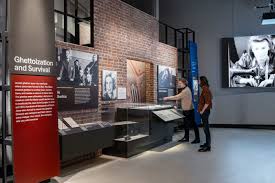|
Getting your Trinity Audio player ready...
|
The Zekelman Holocaust Center and the World Jewish Restitution Organization (WJRO) Announce the Launch of New Website
Site Features Archives Detailing the Persecution, Looting, and Deportation of Jews During the Holocaust in Hungary
New Site Also Provides Information on Looted Art and Artifacts to Help Survivors and their Families Reclaim their Cultural Heritage
Edited by: TJVNews.com
The Zekelman Holocaust Center (The HC) and the World Jewish Restitution Organization (WJRO) have announced the launch of a new website featuring 180 digitized, searchable microfilm reels with more than 160,000 frames related to Jews in Hungary during World War II. A key highlight of this collection is the documentation of Jewish cultural property—including art collections, personal possessions, and valuable assets—seized by the Hungarian government, Nazis, their allies, and collaborators. This extensive archive also tells the story of the systematic persecution and near destruction of Hungary’s Jewish community during the Holocaust, showcasing how lives were upended through exclusion, property confiscation, and eventual deportation.
“We welcome the online release of these critical archives, which tell the story of a people who faced unimaginable persecution and tragic losses during the Holocaust,” said Gideon Taylor, President of the World Jewish Restitution Organization (WJRO). “This archive will help people seeking their lost art and possessions and is a crucial tool for understanding the scale of cultural loss and supporting efforts to seek justice.”
“The efforts by the WWII-era Hungarian government to strip Jews of their possessions was part of the genocidal campaign against Hungarian Jewry during the Holocaust, which must continue to be documented and remembered,” said Rabbi Eli Mayerfeld, CEO of The Zekelman Holocaust Center.
Jonathan H. Schwartz, a litigator and art law expert at Taft – Detroit, who also leads the Jewish Bar Association of Michigan’s Holocaust Art Recovery Initiative, explained: “As a result of the remarkable work of Hungarian Holocaust survivor, Clara Garbon-Radnoti and The Zekelman Holocaust Center, thousands of documents exposing a crucial part of the largest art theft in human history are now available online for the public, governments, and the art world to view, investigate, and finally take appropriate action. This website documents in chilling detail the injustice faced by the Jews of Hungary and is an unparalleled opportunity to learn more about their fate. It comes at a crucial time, when the clock is ticking down for survivors and descendants to seek justice for stolen artwork.”
Donated by the late Prof. Randolph Braham, a renowned scholar of the Holocaust in Hungary, the reels were sourced from the National Archive of Hungary and local repositories. They serve as a stark reminder of the immense cultural and personal losses that remain unaccounted for today.
The collection, comprising thousands of reels created in the 1960s with funding from the World Federation of Hungarian Jews, was sourced from various Hungarian archives and includes invaluable records on looted cultural property. Clara Garbon-Radnoti, a Detroit-area Hungarian Holocaust survivor and volunteer at The HC, dedicated significant time to organizing a comprehensive finding aid in English and translating key portions of Reels 143-145. Her work has made these archives more accessible, allowing for greater research into stolen cultural property.
These reels are particularly valuable for those pursuing claims related to stolen property, especially artwork. They detail the looting of Jewish art collections, including works by Rembrandt, Renoir, and other renowned artists, much of which is believed to remain in Hungarian museums and private collections today. Notably, reel 144C contains detailed documentation of the Herzog Collection, one of Europe’s most significant private art collections before World War II. Assembled by Baron Mór Lipót Herzog, the collection included masterpieces by artists such as El Greco, Francisco de Zurbarán, and Lucas Cranach the Elder. During the Holocaust, the Hungarian government, in collaboration with the Nazi regime, seized these artworks, many of which continue to reside in Hungarian museums. The heirs of Baron Herzog have been engaged in ongoing legal efforts to reclaim these pieces.
The archive’s keyword-searchable index enables users to navigate thousands of stolen items, including the names of victims, what was taken, where and when the thefts occurred, and recipients of looted art. Among the materials highlighted are records detailing the tragic fates of Jewish collectors and their cultural legacies. For example, József Pécsi, a renowned Hungarian Jewish photographer and collector, lost his art collection in the summer of 1944 to Dénes Csánky, a government commissioner tasked with confiscating Jewish-owned art. A bronze plaquette created by Gyula Murányi commemorates Pécsi and is referenced in Reel 145D.
Reel 143, Frame 592 references the painting Sándor Nyilassy: Vasárnap délután (Sunday Afternoon), an oil on canvas owned by Artur Reisner (1878–1955), a Hungarian businessman and factory owner based in Gyula, South Hungary. Reisner operated a family-run match factory until 1939. A painting with this title and similar size was sold multiple times, with one recorded sale by an auction house in December 2005. Further provenance research is needed to verify the connection to most of the items referenced in the archives and to confirm their ownership history.
This extensive archive serves as a primary source documenting how Jews were identified and excluded from Hungarian society, work, and schools, as well as detailing the widespread seizure of Jewish property and possessions. At a time when Holocaust denial, distortion and ignorance are rising, the accounts laid out in this archive are a powerful response to those who would distort the fate of Hungarian Jews and their possessions during the Holocaust.
Hungary endorsed the 1998 Washington Conference Principles on Nazi-Confiscated Art and the 2009 Terezin Declaration, but it has not generally been forthcoming on the provenance of its art and other cultural property collections. The Best Practices for the Washington Conference Principles, developed through the leadership of the World Jewish Restitution Organization (WJRO) and the U.S. Department of State, represents another key advancement in addressing looted art and cultural property and advancing Holocaust-era restitution. Unveiled on March 5, 2024 with video remarks from then Secretary of State Antony Blinken at a joint event with WJRO at the U.S. Holocaust Memorial Museum, the Best Practices expand upon the 1998 Washington Conference Principles. They offer clearer guidelines for resolving claims and provide lessons learned in handling cultural property restitution.
To date, 30 countries have endorsed the Best Practices, though Hungary has not yet done so. Continued international cooperation is essential to address the unresolved issues surrounding looted art and cultural heritage.
“Hungary now has an opportunity to take meaningful action by endorsing the Best Practices and returning property that holds deep personal and historical significance to so many families,” added Taylor.
The Claims Conference-WJRO Looted Art & Cultural Property Initiative, which works globally to recover Jewish-owned art, Judaica, and cultural property lost during the Holocaust, allocated funds for the digitization and translation of the reels. Funding for this project was sponsored by the Foundation “Remembrance, Responsibility and Future” (“EVZ”) and supported by the German Federal Ministry of Finance (“BMF”).
To view the Hungarian microfilm site, visit hfilms.holocaustcenter.org
About The Zekelman Holocaust Center
The Zekelman Holocaust Center was founded by Michigan survivors in 1984 as a lasting memorial to the victims of the Holocaust. Our mission is to engage, educate, and empower through remembrance so that individuals and society will recognize, combat, and prevent anti-Semitism, discrimination and hate-based violence.
The Center teaches history’s darkest period to 100,000 visitors each year, including students and adults of all backgrounds. Our new permanent exhibit places Holocaust victim and survivor stories at the center, making extensive use of archival footage, images and video testimony. Artifacts include an authentic WWII-era boxcar and a sapling from the tree located outside Anne Frank’s hiding place window. The Center also invites the public to make use of its 20,000 volume Library Archive.
Museum Educators and Docents provide customized tours, workshops and programs, empowering visitors to apply the lessons of the Holocaust to create a more compassionate world.
Learn more at www.holocaustcenter.org
Hours: Sunday through Thursday 9:30 am to 5:00 pm and Friday 9:30 am to 3:00 pm. The last admission is one hour before closing. Wheelchair accessible. Free parking. For additional information, visit www.holocaustcenter.org or call 248-553-2400.
WJRO represents world Jewry in pursuing claims for the recovery of Jewish properties in Europe (outside of Germany and Austria). WJRO was established by leading world Jewish organizations to address the restitution of Jewish property and to remind the world that the time has come to redress the enormous material wrongs caused to European Jewry during the Holocaust.




